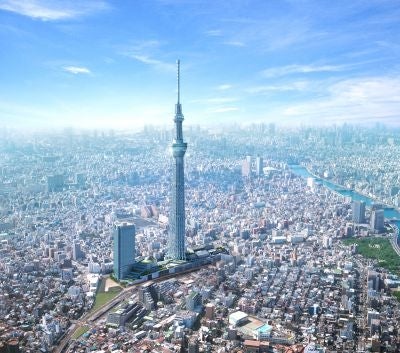Tokyo Sky Tree overcoming the elements

The company building the tallest self-supporting tower in the world has confirmed that it is having problems with the elements as the structure climbs higher, but officials insist it is on schedule to be completed in late 2011.
The Tokyo Sky Tree is inching higher in the Sumida district of the Japanese capital and, at just shy of 400 metres tall, is already the tallest structure in Japan. It was opened to a group of reporters over the weekend for a preview.
When it is completed, the Sky Tree will stand a record-breaking 634 metres tall - with the last 20 meters the late addition of an extra long antenna to the very tip of the building after Tobu Tokyo Sky Tree Co. learned that a rival project in the Chinese city of Guangzhou would be slightly taller.
Even though the Sky Tree will tower over every man-made structure in Japan when it is completed, it would still be dwarfed by the colossal Burj Dubai tower, which stands 828 metres high and was only completed in October last year.
Now towering 398 metres above Tokyo, it has already surpassed the 333-metre high Tokyo Tower and the Yokohama Landmark Tower, a mere 296 metres tall.
But working at such heights - and in a country famous for its susceptibility to earthquakes - the builders are facing some serious challenges.
"At first we were progressing at a speed of about 30 metres a month, but that is not now possible when we are working at this height," Akinobu Fujisawa, a spokesman for the company, told Relaxnews.
"We have as many as 500 workmen on the site at any one time and, on the highest sections, we are having problems with high winds," he said. "It is also proving difficult for the cranes on the top of the towers.
"But we are confident that we will be able to meet the deadline for the completion of the building," he added.
Safety is a key element of the entire process, Fujisawa said, with workers required to have two safely lines attached and all their tools connected to their belts or harnesses. They work within spaces that have been walled off with tarps, to protect them from the elements and to spare them the alarming view of the ground below.
And while the workers are presently battling strong winds and the worst that Japan's rainy season can throw at them, there were a couple of scares earlier in the year. In April, after the latest snowfall in the city in more than four decades, a lump of compacted snow fell off the structure and crashed to the ground. Another incident happened a short while later, although no-one was injured in either incident.
The completed building will have graceful curves that are meant to represent the blade of a samurai sword and other features found in traditional Japanese architecture.
An observation platform at a height of 350 meters will mark the point at which the structure changes from a triangular shape to a cylinder, which is better able to withstand very strong winds. A central shaft, made of reinforced concrete, draws its design from the five-tier pagodas that have dotted the Japanese landscape for hundreds of years - and a remarkably effective in withstanding the potentially devastating effects of earthquakes.
A second observation deck will be at 450 meters above Tokyo, after which the remainder of the tower will rise to a height of 634 meters.
The tower is part of a major urban regeneration project that will include plazas, shopping and entertainment facilities and parks alongside the Kitajukken River.
JR
Join our commenting forum
Join thought-provoking conversations, follow other Independent readers and see their replies
Comments
Bookmark popover
Removed from bookmarks